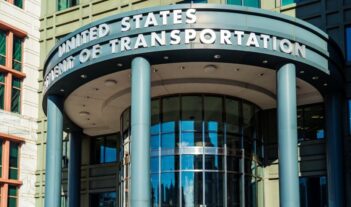
The STB is considering proposals that would hurt the successfully managed freight rail industry.
Although most infrastructure and transportation advocates in Washington, D.C. build their cases on the need for public funding, privately owned freight railroads make the opposite plea: Do not let government regulators disturb the current economic regulatory framework and reduce the ability of freight railroads to invest in their private networks.
Unfortunately, several proposals before the Surface Transportation Board (STB) would needlessly disrupt the unquestioned success of the partial economic deregulation of the railroad industry. If these proposals are adopted, policymakers risk a massive shift of freight from rail to truck that will only exacerbate public infrastructure funding needs.
The plight of American freight rail—caused by overregulation decades ago—is well established. But so is the unquestioned success of the lifting of government shackles on the most important business decisions for the industry—namely routing and pricing. In the 1970s, bankrupt railroads accounted for 21 percent of the nation’s rail mileage, while more than 47,000 miles of track were operated at reduced speeds. Today, consumers are much better off.
Partial economic deregulation put the market in charge of the railroad business while doing away with maximum and minimum rate provisions, allowing railroads to shed unprofitable lines and providing railroads with the freedom to route their trains in the most efficient ways. The industry could for the first time manage assets and pricing privately—without government involvement.
“Deregulation not only saved U.S. freight railroads from further bankruptcies and liquidation, it became, almost miraculously, the catalyst that transformed them into what they are today, the envy of the world’s transportation systems,” says Robert Gallamore, co-author of American Railroads: Decline and Renaissance in the Twentieth Century.
Nonetheless, prominent and powerful rail shippers seek to advance their interests through government intervention and are asking the STB to enact backdoor rate regulations. Re-regulation proponents misleadingly cloak themselves in terms like “free market” and “deregulation,” despite the fact that their “solutions” would regulate far more—a clear break from the goals of the Trump Administration.
So what specifically are the most dangerous proposals under consideration today at the STB as the Board awaits nominations to fill its three vacant leadership positions?
First comes forced switching, which would require railroads to use their privately-owned facilities on behalf of competitors without any showing of competitive abuse. Under a proposal currently pending at the STB, the government would force a railroad to move freight cars over its tracks and hand them over to their competitors. The proponents of such a requirement also seek a limit on the price of such service to a government-set fee, a significant departure from the switching of freight cars among railroads that currently occurs through voluntary, private-market negotiated agreements.
Because switching operations require extensive work, widespread forced switching would greatly reduce network fluidity, drive up costs, and reduce revenues needed for network investment. If the STB were to adopt some of the more radical proposals offered by the proponents of re-regulation, railroads could even be forced to modify existing infrastructure or build new systems to facilitate switching where it is not currently possible.
The proponents of such a misguided policy are clear about why they are unconcerned about these negative effects to the entire network: They hope that government intervention will lower their costs. But artificially driving down railroad revenues is not only bad policy, it is also contrary to law. As the Association of American Railroads argued in a 2017 filing to the STB, the statutory switching provision cannot be used to avoid the detailed requirements for rate regulation the Staggers Act requires. That statute provided “one and only one pathway for a shipper to seek regulatory intervention in response to complaints about rail rates and it sets out specific requirements that must be met.”
As Lawrence J. Spiwak, the president of the Phoenix Center for Advanced Legal and Economic Public Policy Studies, has concluded, “the STB is trying to implement a new… price regulation regime for which ‘competition’ and ‘reciprocal switching’ serve as the thinnest of veils.” And why proceed in this way? “Because the STB’s regular rate regulation standard, rooted in valid economic and financial concepts, represents a hurdle—and a legitimate one—to direct price regulation,” Spiwak has noted.
A second proposal before the STB would authorize the regulation of previously exempt commodities. These would include commodities that the agency has previously determined are subject to pervasive competition—among railroads and other transportation modes, namely trucking. The STB proposed this major reversal without any evidence of market shifts and even though no commodity group petitioned for re-regulation. Revoking exemptions would occur without any thorough economic analysis or review of economic studies on the subject.
If the STB’s proposed rule were made final, commodities that are often moved by truck would no longer be exempt from regulation. This would occur even though existing law provides for a process to revoke an exemption partially when circumstances warrant it.
Finally, a third proposal involves the STB’s continued examination—and possible redefinition—of revenue adequacy, or the notion that each railroad must earn at least enough return on investment to sustain its network both now and in the future.
Instead of annually determining which carriers, if any, earned enough revenue that year to be deemed revenue adequate, it would use revenue adequacy to order railroads to lower prices or pay reparations. This would amount to an unworkable scheme to use overall firm revenues to cap individual customer prices without any consideration of customers’ market demand for service. Such an approach would also inevitably force revenues below the very levels that the agency determined were necessary to maintain the network.
The better approach would be to improve and refine existing rate review processes to ensure that rate cases adhere to the fundamental principles of railroad economics. The STB recently provided its quarterly update to congressional appropriators, noting that it is creating a rate review task force. The rail industry supports making rate disputes less time consuming and expensive, but that must not include redefining revenue adequacy beyond a benchmark of financial health.
These somewhat obscure regulatory proceedings have real-world implications. Even if re-regulation proponents succeed, the ability for railroads to serve them will suffer greatly. Railroads, one of the most capital intensive industries on earth, require ample investment to safely and reliably move goods.
When Congress reauthorized the STB in 2015, it explicitly refrained from directing the STB to embark on any of these proposals. Now is not the time to reverse longstanding precedent.




